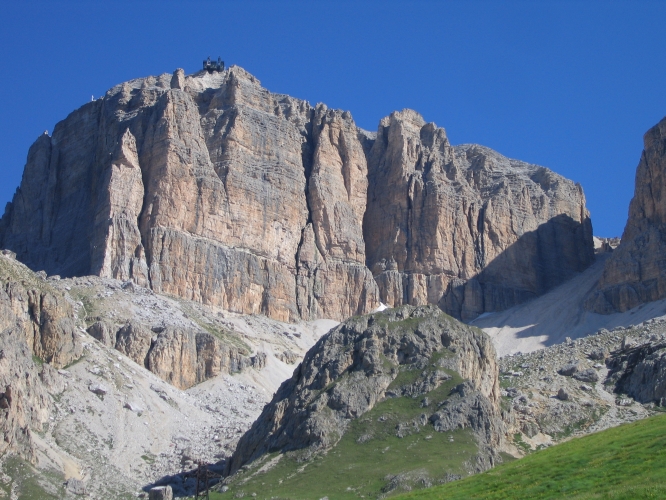Piz Pordoi (Dolomites, Italian Alps; 9,679')
|
Piz Pordoi is the most popular of the peaks in the Sella massif, on account of the cable car that goes straight to the
summit from Passo Pordoi. On foot, the 2,000 vertical feet of trail up the Pordoischarte take one to two hours, depending on
what shape you're in. The massive Northwest Face offers a very long moderate route, and the pillar at the West corner
is the Mariakante. The latter has the dubious distinction of being within shouting range of the cable car, which means that
tourists will wait at the summit to take pictures of the climbers they watched while riding up. Nevertheless, it's a
superb climb, although not exactly a wilderness experience.
A word on alpine ratings .
Routes: Mariakante ( IV+ )
 Pordoischarte (ski descent) Pordoischarte (ski descent) |

 |
References: | A. Köhler and N. Memmel, Classic Dolomite Climbs
(The Mountaineers 1999) |
| | S. Stuflesser, Klettern rund ums Sellajoch
(Lochner Verlag 1997) |
|

Piz Pordoi from just above the Pordoi Pass. The Mariakante starts on the detached pillar to the left,
then crosses over to the main face.
|
| |
|
Party: Dietrich and Paul Belitz
Route: Mariakante
Equipment: alpine rack
Time: Start of route - Summit:
 Roundtrip from Pordoi Pass:
Roundtrip from Pordoi Pass:
Trip report:
For our third day in the Dolomites we picked the Mariakante on Piz Pordoi. Monique had caught the flu I had had earlier,
and was kind of shot from the preceding two days anyway, so she rode up the cable car while Paul and I did the approach
hike up the trail, and then
the scree over to the pillar. The first few pitches go straight up the detached pillar that resembles a Maria statue
until one hits a roof, at which point the route
traverses right into the notch between the pillar and the main wall. Here Paul had to climb a short steep
wall while being on a shaky belay, as I had to undo my anchor to give him the last five feet of rope he needed. I led
the next pitch, and fully agreed with the guidebook's comment to the effect that it requires a leader with balls (the
book puts it more gently), as it consists of a very runout ascending traverse on a steep wall. This pitch ends on the
arete, and the next pitch was enjoyable exposed climbing to easier terrain. The remainder of the climb is a scramble
up low-angled slopes, where one occasionally can get some protection by clipping into a cable that for some reason
runs down the slopes. A few hundred feet of this brought us to the summit, where Monique and photo-hungry tourists
were waiting for us. It was about time, as thunderheads that had worried me for quite a while were now really
congregating right above us. We looked at Piz Boe, but in view of the time and the weather we decided to save it
for some other trip. (We did it the next year.)
A very nice climb, which contributed to our determination to come back and climb some more routes in these
magnificent mountains.



 Roundtrip from Pordoi Pass:
Roundtrip from Pordoi Pass: